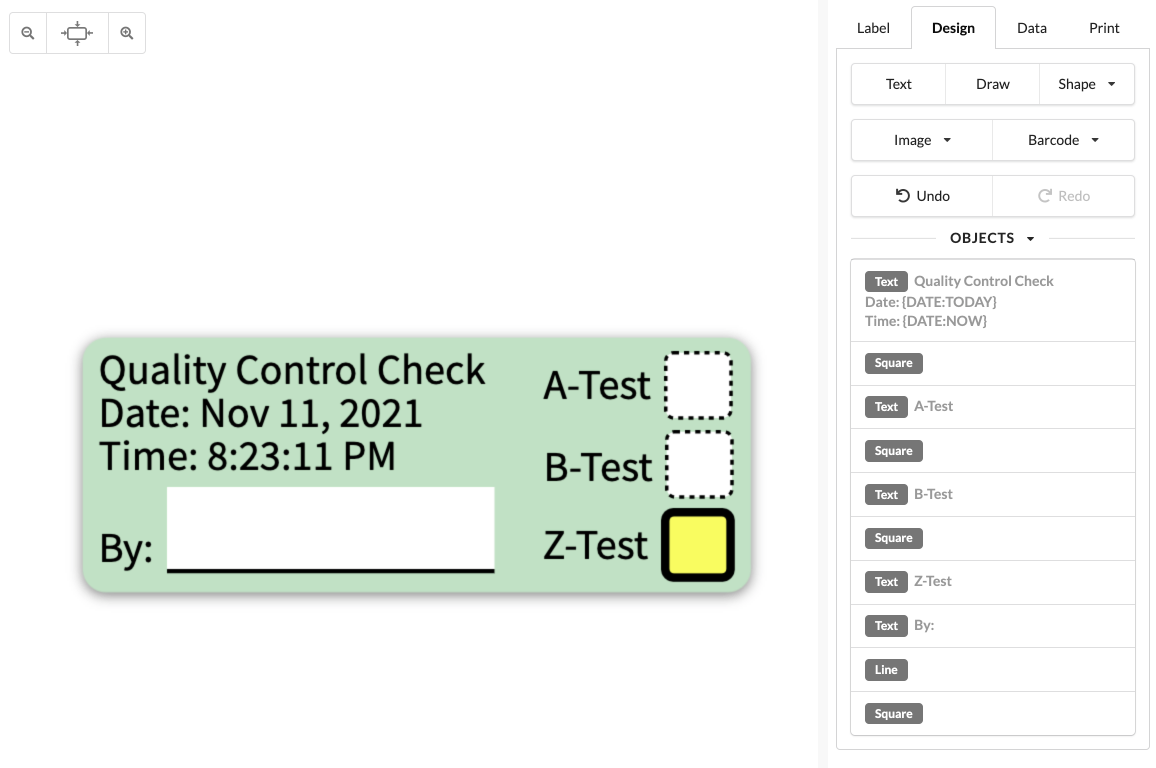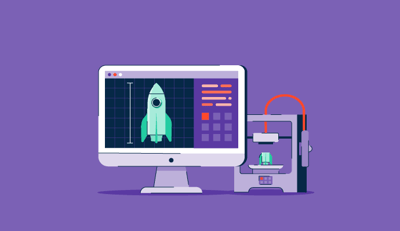Having led a nonprofit dedicated to sending sanitary pads to areas facing scarcity, I’ve personally navigated the challenges of managing shipments and ensuring each parcel reaches its destination with the right information.
Running such an initiative often required me to use the best label printing software, and trust me, it’s not as easy as it seems. From getting the right sizes to ensuring the labels stick properly, there’s a lot of behind-the-scenes work that goes into it. The process can become even more overwhelming when you’re relying on outdated or inefficient tools. The wrong software can lead to errors, wasted time, and a lot of frustration.
That's why finding the right label printing solution is crucial. By streamlining the entire process, you can reduce manual effort and have peace of mind that every label is printed precisely.
5 best label printing software: My picks for 2025
These best label printing software are top-rated in their category, according to G2 Grid Reports. I have also included their standout features and monthly pricing for easy comparison.
| Software |
Best for |
Standout feature |
Pricing |
| Avery Design & Print |
Easy label creation with templates |
Free templates, drag-and-drop editor, designed for Avery labels |
Free |
| Label LIVE |
Collaborative label design |
Cloud-based editor, real-time collaboration, dynamic data import via spreadsheets |
Home plan at $47.99 one-time |
| BarTender |
Enterprise-grade, high-volume labeling |
Automation, data integration, regulatory compliance, scalable label management |
Starter plan at $199/year |
| MarkMagic |
Barcode and RFID label printing |
Barcode/RFID support, integration with enterprise systems like IBM i |
Pricing available on request |
| Loftware Cloud |
Cloud-based label automation |
Centralized label control, regulatory compliance, enterprise system integrations |
Starts at $32.50/month |
Did you know? The global label printing software market is projected to reach USD 1.035 billion by 2034, growing at a 5.1% CAGR from 2024 to 2034.
My top 5 best label printing software recommendations for 2025
Label printing software helped me efficiently manage and streamline the entire labeling process, from generating accurate labels to ensuring they stuck securely on parcels.
With so many options available, I know how overwhelming it can be to find the right one. That’s why I’ve compiled a list of the best label printing software tools for 2025 to help you choose the one that best fits your needs and makes your labeling tasks hassle-free.
These tools aren’t just for nonprofits. Businesses can use them for product shipping, schools for event supplies, and individuals for organizing personal shipments.
No matter the industry, the right label printing software can make the task easier and more efficient.
How did I find and evaluate the best label printing software?
I extensively tested the top label printing software to assess their accuracy and efficiency in streamlining the printing process. Additionally, I used artificial intelligence to analyze G2 reviews and G2’s Grid Reports to evaluate each tool’s features, usability, and overall value.
For tools I couldn’t test firsthand due to access limitations, I gathered insights from small business owners, nonprofit managers, and logistics coordinators with hands-on experience. I then validated their feedback using verified G2 reviews. The screenshots in this article include both those captured during testing and images sourced from the vendor’s G2 page.
By combining hands-on testing, expert opinions, and user reviews, I’ve curated a list of the best label printing software to help you find the right solution for your needs.
What I look for in the best label printing software
When testing the best label printing software, I focus on the following key features to ensure it meets the needs of businesses that require efficient, high-quality label creation and printing:
- Label design flexibility: I assess whether the software offers a wide range of design options, allowing users to create labels of various shapes, sizes, and layouts. The software should support custom dimensions and templates for different label formats (e.g., shipping labels, product labels, barcode labels, and packaging). It should also allow for advanced design customization, including font styles, color schemes, borders, and alignment tools to create professional-looking labels.
- Barcode and QR code generation: I check whether the software includes built-in tools to generate barcodes and QR codes. The ability to easily create different barcode types (e.g., UPC, EAN, Code 128) and customize their size, density, and alignment is essential. For businesses that require product tracking or inventory management, having robust barcode and QR code generation features ensures accurate, scannable labels. I also look at whether the software allows for easy testing of barcode quality before printing.
- Integration with databases and spreadsheets: The best label printing software should be able to integrate with databases, spreadsheets, and other software systems to streamline the label generation process. I assess whether the tool supports importing data from CSV files, Excel spreadsheets, or live databases. This feature is particularly useful for printing large batches of labels with unique data, such as product names, prices, or shipping addresses. I check if the software offers mail merge-like functionality to automate the population of labels with dynamic data.
- Support for different printing methods: I evaluate whether the software is compatible with various label printers, including desktop, industrial, and mobile printers. It should support both thermal transfer and direct thermal printing methods. Additionally, the software should allow users to adjust print settings such as print speed, resolution, and label alignment to optimize quality and efficiency based on the type of printer being used.
- Template library: I assess whether the software offers a rich library of pre-designed templates and layouts to speed up the label creation process. Templates should be available for various industries, including retail, logistics, food and beverage, and healthcare. This feature is especially valuable for users who need to create standard labels quickly without starting from scratch. I also check if users can save their custom designs as templates for future use.
- Batch printing: The software should support batch printing, which is crucial for businesses that need to print large quantities of labels at once. I assess whether the tool allows users to manage print jobs efficiently by queuing multiple label designs or printing in bulk based on dynamic data. Printing hundreds or thousands of labels with minimal intervention is essential for streamlining operations, especially in high-volume environments.
- Integration with inventory and shipping systems: I check if the label printing software integrates with popular inventory management, shipping, and e-commerce platforms (e.g., Shopify, Amazon, UPS, and FedEx). This integration allows businesses to automatically generate shipping labels and track and optimize inventory without manually entering data. It streamlines order fulfillment and ensures consistency between order data and the printed labels.
The list below contains genuine user reviews from our best label printing software category page. To qualify for inclusion in the category, a product must:
- Include templates for various kinds of labels (e.g., shipping, inventory)
- Allow non-technical users to design and print labels
- Provide features to categorize labels and modify them by batch
- Deliver WYSIWYG label designers with options to drag and drop
- Support multiple languages and different types of barcodes
- Comply with regulations or industry standards such as GS1-128
This data has been pulled from G2 in 2025. Some reviews have been edited for clarity.
1. Avery Design & Print: Best for templates
After testing Avery Design & Print, I found it to be a highly convenient tool for creating and printing Avery labels, stickers, and other customizable designs. Recognized as a Leader on the G2 Label Printing Software Grid, Avery Design & Print is a go-to solution for users who value ease of use, template variety, and quick label creation.
One of the biggest advantages was how effortless it was to format everything for printing on Avery stickers. I didn't have to spend time adjusting margins or worrying about alignment—everything fit perfectly right from the start. This made the entire process smooth and saved me a lot of time.
Setting up the software was just as easy. Downloading and installing Avery Design & Print took only a few minutes, and I could jump straight into my project without any unnecessary steps or complications. There was no steep learning curve, and the intuitive workflow allowed me to start immediately.
Another feature I appreciated was the ability to store Avery templates and designs for future use. This was especially useful when I needed to make minor tweaks or reprint a design without starting from scratch. Having my previous templates readily available made redesigning quick and hassle-free.

While I’ve appreciated how intuitive and beginner-friendly this tool is, something that G2 user feedback also highlights, I did notice a few areas where there’s room for refinement. The overall layout gets the job done, but certain parts of the interface felt a bit dated to me. Navigating through different menus required a bit more effort than I expected, which slightly slowed down my momentum during larger projects.
That said, I also saw G2 users mentioning that the templates, though helpful, can feel limiting when it comes to design flexibility. I relate to that, especially when working with font sizes or layout tweaks, I wanted a bit more creative leeway.
In terms of performance, feature switching wasn’t always as smooth as I’d hoped. It didn’t derail my work, and it seems verified G2 users on the product page felt similarly. It’s more of a minor hiccup than a dealbreaker. Still, having a more fluid workflow would definitely enhance the overall experience.
What I like about Avery Design & Print:
- Formatting for Avery stickers was effortless, with perfect alignment and margins right from the start. Eliminating the need for manual adjustments or reformatting saved me a lot of time.
- Setting up the software was quick and straightforward, allowing me to jump straight into my project. The intuitive workflow meant I could start designing without a steep learning curve or unnecessary complications.
What G2 users like about Avery Design & Print:
"I love the wide variety of products available, each thoughtfully designed and easy to use. Formatting everything for sticker printing is effortless, and there are plenty of options to create a fully customized, professional look without overspending."
- Avery Design & Print Review, Megan W.
What I dislike about Avery Design & Print:
- G2 reviewers reported that the user interface felt somewhat outdated and could benefit from a more modern UX design. While functional, navigating through the tool wasn’t as seamless as I had hoped, making some tasks feel clunky.
- The free templates were restrictive, particularly in font sizes and design flexibility. I wanted to experiment with different styles but was limited by the tool’s built-in constraints.
What G2 users dislike about Avery Design & Print:
"Compared to professional design software, Avery Design & Print might offer fewer advanced editing tools. This could be a drawback for users needing specific design elements."
- Avery Design & Print Review, Med A.
Unlock greater efficiency and accuracy in your operations by integrating barcode software.
2. Label LIVE: Best for collaborative label design
I was impressed by Label LIVE's powerful batch printing, which allowed me to effortlessly automate order printouts and label generation. The process was incredibly efficient—by simply dumping a correctly formatted CSV or XML file into a monitored folder, Label LIVE took care of the rest. This saved me a tremendous amount of time and streamlined my workflow significantly. Label LIVE also earns the Highest Performer badge on G2 for delivering powerful, collaborative label design tools with a lightweight interface and real-time flexibility — ideal for agile teams.
Another aspect I appreciated was the What You See Is What You Get (WYSIWYG) designer interface, which provided a seamless printing experience across different printers. I even tested it on an 80mm printer, and the results were surprisingly crisp and well-aligned.
Another strong point was the software’s deep integration with programming logic, as I could dynamically show or hide elements based on conditions. Additionally, the ability to integrate directly with spreadsheets using variables made it easy to automate and customize label generation without manual intervention.

One thing I appreciated about this software is how it simplifies the overall label design process—something many users also highlight in G2’s community. That said, I noticed a few areas where the experience could be even smoother. For instance, when something didn’t go as expected, the error messages weren’t always clear. I often had to figure things out on my own, and based on insights from G2 reviewers, I’m not alone in wishing those messages offered a bit more guidance.
I also came across occasional hiccups with the print preview feature. Even with my printer correctly selected and listed as compatible, the software still prompted that no printer was found. A few verified G2 users mentioned similar issues—it’s not widespread, but it can slow things down when you’re ready to print and need to verify layout accuracy.
As for setup, dialing in label sizes for certain printers required more manual input than I expected. Once it was all configured, the system worked reliably, but during setup, several G2 users shared that they, too, had to spend extra time adjusting dimensions and formatting. Overall, while the core functionality holds up well, a few refinements could make the process more seamless.
What I like about Label LIVE:
- Label LIVE’s batch printing automation was incredibly efficient. By simply dropping a correctly formatted CSV or XML file into a monitored folder, I could generate order printouts and labels effortlessly, saving me significant time.
- The WYSIWYG designer interface ensured seamless printing across different printers. I tested it on an 80mm printer, and the results were sharp, well-aligned, and consistent, making it highly reliable.
What G2 users like about Label LIVE:
"I successfully created labels for a medical device that complied with the U.S. Food and Drug Administration (FDA) regulations and followed GS1 standards for serial numbers. I was able to generate barcodes easily using a simple Excel spreadsheet. The customer support team was extremely helpful, even assisting me in creating the labels."
- Label LIVE Review, J J C.
What I dislike about Label LIVE:
- The error messages were not descriptive enough, forcing me to troubleshoot issues through trial and error. G2 users needed a clearer explanation of problems to save time.
- The print preview feature didn’t always recognize my selected default printer. Despite being listed, the software reported that no printer was found, requiring extra steps to verify label formatting before printing.
What G2 users dislike about Label LIVE:
"Label creation could be faster. When printing more than 100 different labels, the process can take up to 10 minutes, which can be time-consuming."
- Label LIVE Review, Tommy Y.
3. BarTender: Best for enterprise-grade labeling
After testing BarTender, I found it to be a robust and versatile barcode label printing software. It is widely used for creating and printing barcodes, RFID tags, and more. Also, BarTender is known for the most niche option on G2's label printing category, catering to complex, enterprise-grade labeling needs with deep automation and regulatory compliance capabilities.
One of its biggest strengths is the availability of pre-built templates, which significantly sped up the design process. Instead of starting from scratch, I could choose from various templates and customize them to fit my needs. This was especially helpful when working under tight deadlines, as I could quickly tweak existing designs rather than building everything from the ground up.
Additionally, BarTender’s ability to pull variable data from external databases or Excel added a powerful automation layer. This feature allowed me to create dynamic labels without manually inputting information, which is a huge advantage for businesses handling large-scale labeling.

BarTender’s strength lies in its depth—once you're familiar with the system, it’s clear how much power it offers in terms of customization and automation. This is something many BarTender reviewers on G2 consistently highlight. However, getting to that point wasn’t exactly straightforward. When I started setting up user roles and permissions, I found the process unclear. From what I’ve seen on verified G2 user feedback, others have had similar experiences—there’s a shared desire for more detailed guidance on managing team access effectively.
The software’s robust feature set is impressive, but it does come with a learning curve. While there are video tutorials out there, they tend to focus on broader concepts rather than addressing nuanced use cases. Based on G2 sentiment analysis, a more structured and comprehensive support library would go a long way in helping new users get up to speed without relying so heavily on trial and community forums.
Once everything is in place, the system performs well. But for new users—myself included—it would be helpful if onboarding resources were a bit more tailored and thorough, especially given the software’s enterprise-level capabilities.
What I like about BarTender:
- BarTender’s pre-built templates made label design much faster. I could quickly customize these templates, which was especially useful when I was working under tight deadlines.
- The ability to pull variable data from external databases or Excel streamlined label creation. This automation feature saved time and effort, particularly for businesses dealing with large-scale labeling.
What G2 users like about BarTender:
"Printing labels is easy, and the software integrates seamlessly with other programs using data connections. It can communicate with databases, run queries before printing, perform checks, and gather additional data to ensure accurate labeling."
- BarTender Review, Verified User in Electrical/Electronic Manufacturing
What I dislike about BarTender:
- The lack of clear documentation for managing user permissions made deployment and access control confusing. I had to experiment extensively before finding an effective way to control user settings, which was time-consuming.
- BarTender has a steep learning curve despite its powerful features. The available YouTube tutorials were good for general use cases, but for specific issues, they didn’t provide the depth I needed. This does call for new content that can make the learning process for newbies like me smoother.
What G2 users dislike about BarTender:
"It is challenging to understand the deployment process, product limitations, and how to set user restrictions, making it difficult for end users to navigate."
- BarTender Review, Larry M.
Unlock the full potential of your label printing process by integrating RFID software—streamline inventory management and improve tracking accuracy today.
4. MarkMagic: Best for barcode and RFID label printing
I found MarkMagic to be highly customizable. The ability to export and import different formats made it extremely versatile, allowing me to work with various file types seamlessly. This flexibility was particularly useful when dealing with multiple labeling requirements across different platforms. Also, I learnt that MarkMagic holds a 4.6 out of 5 rating on G2.
Another major plus was the fact that MarkMagic runs entirely in the browser, eliminating the need for software installation. This made it incredibly convenient to access from any device without worrying about system compatibility or updates. Additionally, the graphical user interface (GUI) was easy to learn, making the onboarding process smooth and intuitive.
I also appreciated how effortlessly MarkMagic integrated with existing systems, allowing for quick implementation without requiring major adjustments. Its cloud-based nature was another huge benefit for me, as it ensured accessibility from anywhere while reducing the need for local storage or maintenance.

That said, the interface itself could benefit from a refresh. Some parts feel a little dated, and based on G2 user comments, I’m not the only one who thinks a more modern design would make everyday navigation more intuitive.
When it came to text formatting, things required a bit more manual adjustment than I expected. I noticed this especially while positioning and styling text on labels, G2 customer reviews mentioned the same: the controls work, but they could feel more responsive and streamlined.
I also noticed that working with images—particularly aligning them on forms—took extra care. It wasn’t a major setback, but ensuring the right resolution and placement took additional steps. Others on G2’s product page pointed out similar experiences, suggesting that enhancements to image formatting would add a lot of value without altering core functionality.
What I like about MarkMagic:
- MarkMagic’s ability to export and import various formats made it highly versatile. This flexibility allowed me to seamlessly handle different file types, which was especially helpful for managing multiple labeling requirements.
- Running entirely in the browser, MarkMagic eliminated the need for software installation. This cloud-based setup made it easy to access from any device and ensured I didn't have to worry about system compatibility or updates.
What G2 users like about MarkMagic:
"I appreciate the customization options, such as setting up print jobs and the ability to import and export in different formats. Additionally, since everything runs in a web browser, there’s no need to install any software, making it more convenient and accessible."
- MarkMagic Review, Stepan K.
What I dislike about MarkMagic:
- The user interface could benefit from modernization. Some elements felt outdated, and a more polished design would improve navigation and overall usability.
- I faced challenges with text formatting in J-Magic, which was not as smooth as expected. Adjusting text styles and placements required more manual effort than anticipated.
What G2 users dislike about MarkMagic:
"I've encountered challenges with MarkMagic when using two-dimensional (2D) barcodes, as they take significantly longer to generate compared to one-dimensional (1D) linear barcodes. Additionally, formatting images correctly for use on forms has been problematic."
- MarkMagic Review, Craig L.
5. Loftware Cloud: Best for cloud-based label automation
Loftware Cloud is a highly efficient and user-friendly labeling solution, ideal for environments that demand quick label creation under pressure. Its ease of use allowed me to design and print labels rapidly, even as a beginner, saving valuable time I would have spent learning a new tool.
One of Loftware Cloud's standout benefits is its scalability, making it a strong fit for organizations of all sizes. Whether you're printing simple labels or managing high-volume, complex label production, the software adapts easily to evolving business needs.
In terms of design, Loftware Cloud excels with various features that make label creation both creative and functional. The drag-and-drop functionality made it easy to design professional-quality labels, even without advanced graphic design experience. Pre-defined templates were incredibly helpful for streamlining the design process, while the ability to save custom designs as templates ensured consistency across multiple projects. Adding barcodes to labels was equally easy, requiring only the selection of the appropriate barcode symbology—no technical expertise was necessary.
I was also impressed with the multi-printer configuration, allowing seamless printing across various locations or teams. The ability to distribute the workload across multiple servers significantly enhanced the system’s performance, ensuring that label printing remained smooth and uninterrupted even during high-demand periods.

However, Loftware Cloud does have a few drawbacks worth noting. One challenge I came across involved occasional bugs that disrupted my workflow. In these instances, the error messages didn’t always provide clear guidance, which made it harder to identify the root cause. Insights from G2 reviewers have shared similar feedback, suggesting that clearer messaging would go a long way in simplifying troubleshooting.
The configuration process also felt a bit involved. As several G2 users pointed out, setup includes multiple steps, and without prior familiarity with the platform, getting everything in place took longer than anticipated.
I did value the ability to use JavaScript for more advanced label customization—it’s a powerful feature—but working in the script editor wasn’t as smooth as I hoped. Notable patterns in G2 reviews also noted that the editor window feels cramped, and the lack of a monospace font made code editing slightly less convenient than expected.
Lastly, field sizing in the label design interface behaved inconsistently. During design, certain fields appeared to take up more horizontal space than they actually did once printed. This led to a few layout mismatches that required a bit of adjustment. That said, this seems to be a common experience among G2 reviewers, especially those creating more detailed or data-rich label templates.
What I like about Loftware Cloud:
- Loftware Cloud was incredibly efficient and user-friendly, enabling me to design and print labels quickly without any steep learning curve. This allowed me to save time and focus on other tasks, even when working under pressure.
- The software’s scalability made it a perfect fit for my needs, whether I was printing simple labels or handling high-volume production. It adapted seamlessly to my evolving requirements, which was especially valuable as my labeling demands grew.
What G2 users about Loftware Cloud:
"Once the software is installed and set up, creating and testing new labels is quick and easy. Adding new fields is a simple drag-and-drop process, and formatting tasks like adjusting font size, alignment, and text manipulation—such as concatenation and trimming—are effortless. Barcodes can be added without any prior knowledge as long as you know the required symbology. Adding additional printers is also straightforward. Overall, the software offers excellent value for an enterprise-level solution."
- Loftware Cloud Review, Ben R.
What I dislike about Loftware Cloud:
- I faced occasional bugs that disrupted my workflow. The lack of clear error messages made troubleshooting challenging, slowing the process for many G2 users.
- The configuration process was more complex than I anticipated, with multiple steps involved. This made setup take longer than expected, especially for G2 users unfamiliar with the platform.
What G2 users dislike about Loftware Cloud:
"Sometimes, labels don’t generate correctly based on the serial number. There are also several bugs, such as changes not applying immediately and only reflecting after logging out and logging back in."
- Loftware Cloud Review, Abhash K.

Best label printing software: frequently asked questions (FAQs)
Q1. Do I need special software to print labels?
Yes, specialized label printing software is often recommended. These tools offer templates, barcode generation, and customization features tailored to label design and printing. They help ensure labels are formatted correctly and can support various printers, ensuring consistent results.
Q2. What is the best format for printing labels?
The best format for printing labels is typically PDF or PNG for high-quality output. These formats preserve design elements, fonts, and images in print-ready resolution, ensuring labels appear professional and clear when printed.
Q3. Which printing method is better?
Thermal printing is ideal for high-volume, fast-label printing with no ink required. Inkjet printing provides better color accuracy, while laser printing offers precision and speed for larger volumes. Choose based on label material, durability, and color requirements.
Q4. Should I print in CMYK or RGB?
When choosing between CMYK or RGBF for label printing, you should print in CMYK (Cyan, Magenta, Yellow, and Black) mode, as this is the standard color model for printers. RGB (Red, Green, Blue) is ideal for digital screens but doesn’t translate accurately to print, affecting color quality.
Q5. Which is the best free label printing software?
Label Live is one of the best free-label printing software options. It offers a simple, user-friendly interface with essential features like barcode creation, template selection, and print preview. Explore other free label printing software.
May all your labels stick where they belong!!
The best label printing software I tested offers various features to meet different business needs, from ease of use and customization to powerful integrations and high-volume printing capabilities.
But remember, your requirements might differ depending on the size of your business or the complexity of your labels, so it’s always a good idea to test out a few options before settling on one.
And don’t forget, while it’s crucial to get the perfect label printed, it’s just as important to place it on the right box. Because, let’s face it, the last thing you want is for that "fragile" label to end up on a box full of rubber bands instead of glassware.
Design and customize labels like a pro with the best graphic design software.
.png?width=400&height=150&name=Untitled%20design%20(56).png)
.png?width=690&name=G2CM_FI931_Learn_Article_Images_%5Bdata_labeling_stats%5D_V1b%20(1).png)






.png)





.png)